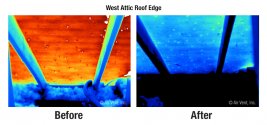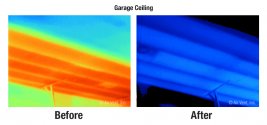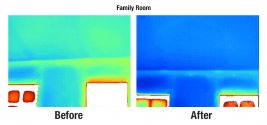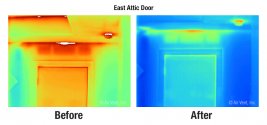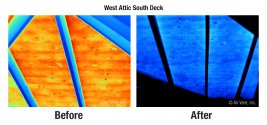The goal of the case study was to compare an unbalanced attic ventilation system (which is an attic with unequal distribution of intake vents and exhaust vents) to a balanced attic ventilation system (which is an attic with an equal or close to equal amount of intake vents and exhaust vents) in terms of heat buildup and kilowatt hours.
Air Vent partnered with Risk Management & Engineering (Garland, TX) to study a house in Mansfield, TX (a suburb of the Dallas-Fort Worth Metroplex) analyzing temperature readings in 30 different attic and living space locations. On both the “before” test day
(the unbalanced attic ventilation system) and the “after” test day (the balanced attic ventilation system) thermo-graphic photo and temperature readings were taken during 12-hour periods. Both test days had similar maximum outdoor temperatures (approximately 98°F) and solar insolation (the radiant heat energy from the sun that heats the roof deck).
The case study house in Mansfield has three attics.
- East Attic: 2,136 square feet
- West Attic: 813 square feet
- Garage Attic: 140 square feet
The unbalanced attic consisted of a mix of ridge vents and electric power fans without intake ventilation. Mixing more than one type of exhaust vent on the same house is not recommended because it could short-circuit the ventilation system and possibly allow weather infiltration into one of the exhaust vents. Furthermore, without intake vents, the attic is not being properly ventilated. When the Mansfield house was re-roofed due to hailstorm damage, a balanced attic ventilation system was installed which consisted of electric power fans repositioned for maximum efficiency and Air Vent’s Edge™ Vent — a shingle-over, roof-top installed intake vent. Note: Although ridge vents are generally the best way to exhaust vent an attic, power fans are a good “Plan B” when the roof is not a suitable candidate for horizontally installed ridge vents at the roof peak. Another option is diagonally installed Hip Ridge Vent.
Note: All photos on this page are ©Air Vent, Inc. and should be identified as such in any format you use them.
Click an image to enlarge:
Highlights of the temperature and energy savings:
- Maximum roof deck temperatures dropped 22.5°F (from 146.5°F to 124°F).
- Maximum attic temperatures dropped 9.3°F (from 123.2°F to 113.9°F).
- Maximum interior surface temperatures dropped 6.4°F (from 83.1°F to 76.7°F).
- Kilowatt Hours dropped 20% (from 130 to 104).
pdf Thermal Imaging Case Study Results: Balanced Attic Ventilation Can Save Energy & Money
The goal of the case study was to compare an unbalanced attic ventilation system (which is an attic with unequal distribution of intake vents and exhaust vents) to a balanced attic ventilation system (which is an attic with an equal or close to equal amount of intake vents and exhaust vents) in terms of heat buildup and kilowatt hours. Air Vent partnered with Risk Management & Engineering (Garland, TX) to study a house in Mansfield, TX (a suburb of the Dallas-Fort Worth Metroplex) analyzing temperature readings in 30 different attic and living space locations. On both the “before” test day (the unbalanced attic ventilation system) and the “after” test day (the balanced attic ventilation system) thermo-graphic photo and temperature readings were taken during 12-hour periods. Both test days had similar maximum outdoor temperatures (approximately 98°F) and solar insolation (the radiant heat energy from the sun that heats the roof deck).
Assuming 20 cents per Kilowatt hour, as the homeowner was paying in Mansfield, the case study yielded approximately $52 savings over 10 days or $312 savings over 60 days with an average outdoor temperature of 86°F.
“The results of our testing clearly showed that not only was the temperature of the air inside the attic reduced, the temperature of the roof deck materials was reduced; the temperature of the building materials inside the house was also reduced,” says David Weeks, P.E., CIH, senior engineer at Risk Management & Engineering. “The results of our testing clearly showed that the Air Vent balanced attic ventilation system resulted in demonstrated energy savings.”


